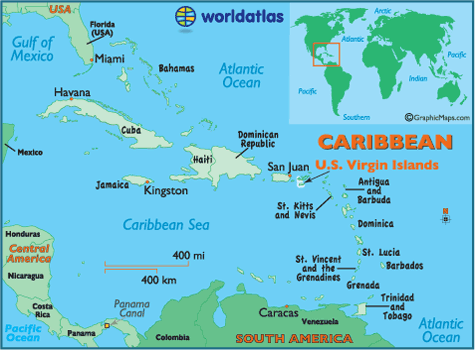Virgin Islands (U.S.)
A TERRITORY OF THE UNITED STATES, roughly 65 km (40 mi) east of PUERTO RICO, these islands were named by Christopher Columbus in honor of the 11,000 martyred companions of Saint Ursula, Las Once Mil Virgenes. Today, these islands are split into two groups: the largest islands form an organized, unincorporated territory of the United States, while the smaller islands to the east have been a crown colony of the UNITED KINGDOM since the 17th century. Both the U.S. and British Virgins rely heavily on tourism, an industry for which they are well equipped, with plentiful sun, lush tropical vegetation and excellent diving.
The U.S. Virgin Islands are made up of over 50 islands and islets, but only three have much land area or population: most of the population is split evenly between Saint Thomas (28 square mi or 72 square km) and Saint Croix (84 square mi or 215 square km), while a small number live on Saint John (20 square mi or 51 square km). Two-thirds of the island of Saint John is covered by the forests of the Virgin Islands National Park, on land donated by the Rockefeller family in 1956.

The islands are volcanic in origin and are mostly hilly, with little flat land. There is not much variation
in seasonal temperatures, and although there is a rainy period in summer, the islands receive insufficient water, which must be imported from Puerto Rico. The islands are also frequently in the path of tropical storms and occasional earthquakes. The heavily indented coasts make fine natural harbors and coves—Charlotte Amalie, on Saint Thomas, is considered one of the best natural deepwater harbors in the CARIBBEAN SEA.
It was these harbors and the islands' strategic position along the Anegada Passage, the widest deepwater channel between the ATLANTIC OCEAN and the Caribbean, that first attracted the European colonial powers to these islands. Hoping to keep up with his larger neighbors, the king of DENMARK authorized the establishment of a Danish West India Company, which set itself up in the harbors of Saint Thomas and Saint Croix in the later part of the 17th century. As on other islands of the West Indies, some sugar plantations were established (especially on Saint Croix), but the ports of Christiansted and Charlotte Amalie became prominent not as sugar exporters, but as major trade centers, not just for sugar, cocoa, or tobacco, but in African slaves. English, not Danish, was generally the lingua franca, and the islands today reflect a mixture of English, Danish, French, Spanish, Dutch, and African cultural influences.
The Danes were the first to abolish the slave trade, in 1802, and the islands lost their economic importance to Denmark. The United States began to show interest from the 1870s, as plans were laid for the building of the PANAMA CANAL. As the Anegada Passage was one of the principal approaches to the canal (completed in 1914), the U.S. saw the need to protect this crucial shipping lane and bought the islands from Denmark in 1917, for $25 million.
Today, most of the sugar plantations on Saint Croix are closed, but the islands still produce their famous bay rum. Charlotte Amalie focuses on tourism and, as a free port, has a developing offshore finance industry. Other industries are concentrated on Saint Croix, notably petroleum refining—with one of the largest refineries in the world—but also production of bauxite, rum, textiles, and pharmaceuticals. These industries, along with 2 million visitors a year, give the U.S. Virgins one of the highest standards of living in the Western Hemisphere. The islands gained additional autonomy in internal affairs in 1993, but there is no move toward further independence from the United States.